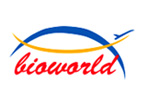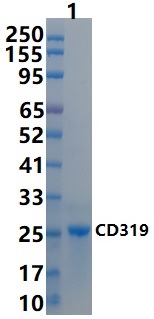Product Name :
CD319 Recombinant Protein Swiss-Prot :
Q9NQ25 Host :
E.coli Tag :
≥0.5mg/ml Amino acid Sequence :
SGPVKELVGSVGGAVTFPLKSKVKQVDSIVWTFNTTPLVTIQPEGGTIIVTQNRNRERVD FPDGGYSLKLSKLKKNDSGIYYVGIYSSSLQQPSTQEYVLHVYEHLSKPKVTMGLQSNKN GTCVTNLTCCMEHGEEDVIYTWKALGQAANESHNGSILPISWRWGESDMTFICVARNPVS RNFSSPILARKLCEGAADDPDSSM Restriction sites :
NdeI-XhoI Background :
CRACC/SLAMF7/CD319 (also known as CS1) is a member of the signaling lymphocytic activation molecule (SLAM) family. It is a single-pass type l transmembrane glycoprotein expressed on NK cells, subsets of mature dendritic cells, activated B and T lymphocytes, but not in promyelocytic B or T cell lines. Expression of this protein has been detected in the spleen, lymph node, peripheral blood leukocytes, bone marrow, small intestine, stomach, appendix, lung, and trachea. Homophilic interactions of CRACC/SLAMF7/CD319 modulate the activity and differentiation of immune cells. CRACC/SLAMF7/CD319 may function as an inhibitory or activating receptor in immune cells depending on cellular context and availability of adapter proteins, SH2D1A/SAP and/or SH2D1B/EAT-2. In the presence of SH2D1B/EAT-2, CRACC/SLAMF7/CD319 activates NK cells and B cells. T cells lack SH2D1B/EAT-2 expression, and therefore CRACC/SLAMF7/CD319 acts as an inhibitory receptor. In LPS-activated monocytes, CRACC/SLAMF7/CD319 negatively regulates production of proinflammatory cytokines. CRACC/SLAMF7/CD319 is upregulated in multiple myeloma and is implicated in the uncontrolled proliferation of these cells, and thus has become the target for therapeutic intervention. Seven isoforms of CRACC/SLAMF7/CD319 produced by alternative splicing have been identified. Soluble :
PBS, 4M Urea, PH7.4 Purification&Purity :
Transferred into competent cells and the supernatant was purified by NI column affinity chromatography and the purity is > 85% (by SDS-PAGE). Storage&Stability :
Store at 4°C short term. Aliquot and store at -20°C long term. Avoid freeze-thaw cycles. Expression vector :
pet-22b(+) BiowMW :
~25kDa Note :
For research use only, not for use in diagnostic procedure. concentration :
≥0.5mg/ml
CD319 Recombinant Protein Swiss-Prot :
Q9NQ25 Host :
E.coli Tag :
≥0.5mg/ml Amino acid Sequence :
SGPVKELVGSVGGAVTFPLKSKVKQVDSIVWTFNTTPLVTIQPEGGTIIVTQNRNRERVD FPDGGYSLKLSKLKKNDSGIYYVGIYSSSLQQPSTQEYVLHVYEHLSKPKVTMGLQSNKN GTCVTNLTCCMEHGEEDVIYTWKALGQAANESHNGSILPISWRWGESDMTFICVARNPVS RNFSSPILARKLCEGAADDPDSSM Restriction sites :
NdeI-XhoI Background :
CRACC/SLAMF7/CD319 (also known as CS1) is a member of the signaling lymphocytic activation molecule (SLAM) family. It is a single-pass type l transmembrane glycoprotein expressed on NK cells, subsets of mature dendritic cells, activated B and T lymphocytes, but not in promyelocytic B or T cell lines. Expression of this protein has been detected in the spleen, lymph node, peripheral blood leukocytes, bone marrow, small intestine, stomach, appendix, lung, and trachea. Homophilic interactions of CRACC/SLAMF7/CD319 modulate the activity and differentiation of immune cells. CRACC/SLAMF7/CD319 may function as an inhibitory or activating receptor in immune cells depending on cellular context and availability of adapter proteins, SH2D1A/SAP and/or SH2D1B/EAT-2. In the presence of SH2D1B/EAT-2, CRACC/SLAMF7/CD319 activates NK cells and B cells. T cells lack SH2D1B/EAT-2 expression, and therefore CRACC/SLAMF7/CD319 acts as an inhibitory receptor. In LPS-activated monocytes, CRACC/SLAMF7/CD319 negatively regulates production of proinflammatory cytokines. CRACC/SLAMF7/CD319 is upregulated in multiple myeloma and is implicated in the uncontrolled proliferation of these cells, and thus has become the target for therapeutic intervention. Seven isoforms of CRACC/SLAMF7/CD319 produced by alternative splicing have been identified. Soluble :
PBS, 4M Urea, PH7.4 Purification&Purity :
Transferred into competent cells and the supernatant was purified by NI column affinity chromatography and the purity is > 85% (by SDS-PAGE). Storage&Stability :
Store at 4°C short term. Aliquot and store at -20°C long term. Avoid freeze-thaw cycles. Expression vector :
pet-22b(+) BiowMW :
~25kDa Note :
For research use only, not for use in diagnostic procedure. concentration :
≥0.5mg/ml
Blocking peptide available as NCP0319P

 CD319 Recombinant Protein
CD319 Recombinant Protein 
 Datasheet
Datasheet COA
COA MSDS
MSDS SHIP
SHIP